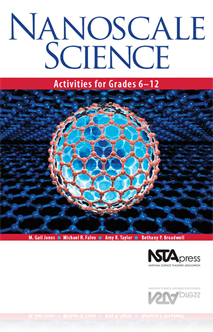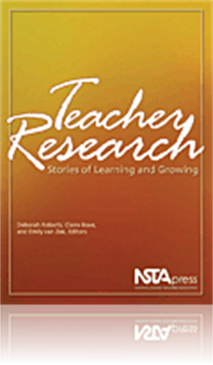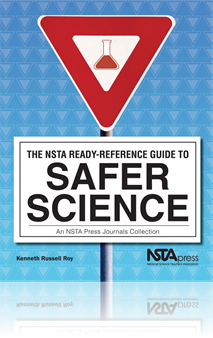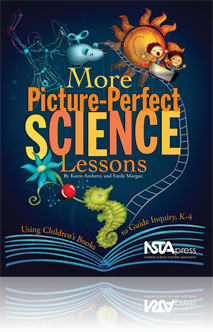All Book Chapters
Book Chapter
It’s a Small World After All: Nanofabric
Nanotechnology is producing a variety of new materials we use in our everyday lives. One such development is the latest stain-resistant fabric. This inquiry activity gives students the opportunity to explore and discover unique nanoscale properties o...
Book Chapter
Becoming a Teacher Researcher: Giving Space, Finding Space
Christopher Horne is a teacher specialist for elementary science for Frederick County, Maryland, public schools and an adjunct professor in the education department at Mount Saint Mary’s University in Emmitsburg, Maryland. He is pursuing a doctoral...
Book Chapter
Teachers Supporting Teachers in Learning
Diantha Lay is principal of an elementary school in Montgomery County, Maryland. When she wrote this chapter, she was just starting a new position for the county as a staff development teacher. Earlier she had been a second- and a fourth-grade teache...
Book Chapter
TEAM Connections: Four Teachers’ Journeys Into Action Research
Judy Fix, Norma Fletcher, Dianne Johnson, and Janet Siulc—a group of teachers in the Buffalo Public School District—wondered what they could do that would go beyond talk and speculation about their teaching practices. They wanted to take action i...
Book Chapter
Learning About Motion: Fun for All
Deborah Roberts is a fifth-grade teacher in Phoenix, Arizona. At the time she wrote this chapter, she was a middle-school science teacher in a high-poverty suburban school in Maryland. An earlier version of this paper was presented at the University ...
Book Chapter
Reflections on Fostering Teacher Inquiries Into Science Learning and Teaching
Emily van Zee is an associate professor of science education at Oregon State University and co-organizer of Teacher Researcher Day at National Science Teachers Association (NSTA) national conferences. She has been a middle school science teacher, sco...
Book Chapter
Reading, Writing, Comprehension, and Confidence—Achieved in Science Contexts
When Elizabeth Kline wrote this, she was a fifth-grade teacher in Prince George’s County, Maryland. A desire to integrate scientific concepts in a curriculum dominated by reading, writing, and mathematics motivated her to change the way she taught ...
Book Chapter
Fourth-Grade Scientists Investigate Electric Circuits
Trisha Kagey Boswell is a third-grade teacher at an elementary school in Montgomery County, Maryland, where she has taught for eight years. Her school is an art-integrated magnet school. When she wrote this chapter, she was a first-year teacher, teac...
Book Chapter
Ellen Franz is a teacher at an elementary school in the Sausalito Marin City School District, a small district just north of San Francisco. When she wrote this poem, she was teaching primary grades in a midsized urban school district and had been in ...
Book Chapter
When students Don’t Talk: Searching for Reasons
Mary Bell has taught for 23 years in a large suburban school district near Washington, DC. As an elementary special education and Reading Recovery teacher, she cotaught reading, science, and math as part of an inclusion model. Currently, she is worki...
Book Chapter
Evolving Ethical Perspectives in an Eighth-Grade Science Classroom
Matthew Ronfeldt’s dissertation as a doctoral candidate in Curriculum and Teacher Education at Stanford University is a crossprofessional study of how professional education supports novice teachers and clinical psychologists in adapting to their n...
Book Chapter
Student Teaching as Collaboration
For teachers who are trying to understand what their students think and how they feel, data can include notes found on the floor after class, the letters they as teachers write to their students, and the e-mails they send each other as they puzzle ou...
Book Chapter
Collaborative Conversations and Intentional Reflections on Teaching and Learning Physics
Dorothy Simpson taught mathematics for 15 years before she started teaching physics at Mercer Island High School near Seattle. Now retired, she is serving as a volunteer at a local elementary school with special interest in providing support for the ...
Book Chapter
In some ways, the laboratory safety standards may seem at odds with science laboratory curriculum expectations in an environment attempting to provide for full inclusion of all students. Clearly, not all students will be able to be fully mainstreamed...
Book Chapter
Learners explore the invention process by learning about inventions throughout history and how inventions fill needs or wants, by improving existing inventions, and by keeping a toy invention journal. They further their understandings of the risks an...
Book Chapter
The purpose of this assessment probe is to elicit students’ ideas about seeds. It specifically probes to find out if students recognize that a seed has needs, similar to other organisms that allow it to develop into the next stage of its life cycle...
Book Chapter
The purpose of this assessment probe is to elicit students’ ideas about plant growth. It specifically probes to find out if students think plants only grow if they are exposed to light....
Book Chapter
The purpose of this assessment probe is to elicit students’ ideas about food and plants. The probe is designed to reveal whether students use a biological concept of food to identify what plants use for food....
Book Chapter
The purpose of this assessment probe is to elicit students’ ideas about transformation of matter. The probe is designed to reveal whether students recognize that a gas from the air (carbon dioxide) is combined with water and transformed into the ne...
Book Chapter
The purpose of this assessment probe is to elicit students’ ideas about cell size. The probe is designed to find out if students think that animal cell size is related to the overall size of an animal. ...
Book Chapter
The purpose of this assessment probe is to elicit students’ ideas about when objects can be seen in the sky. Students’ explanations reveal their thinking about the role of light and distance in seeing sky objects. ...
Book Chapter
The purpose of this assessment probe is to elicit students’ ideas about density and buoyancy. The probe is designed to find out how students think an object can be made to float differently. ...
Book Chapter
The purpose of this assessment probe is to elicit students’ ideas about density. The task is designed to find out if students think a solid object will float differently if it has holes poked all the way through it or if they confuse it with mixed ...
Book Chapter
The purpose of this assessment probe is to elicit students’ ideas about boiling point. The probe is designed to find out whether students recognize that if a liquid is boiling under standard conditions, the boiling point remains constant, no matter...
Book Chapter
The purpose of this assessment probe is to elicit students’ ideas about particles during a change in state. The probe is designed to find out if students recognize that the bubbles formed when water boils are the result of liquid water changing int...
Book Chapter
The purpose of this assessment probe is to elicit students’ ideas about chemical bonds. The probe is designed to find out if students think bonds are physical matter or attractions between electrons. ...
Book Chapter
Fact or Fiction: Exploring the Myths and Realities of Nanotechnology
Will clouds of self-replicating nanobots take over the world, or is this just a scene from a science fiction novel? Nanotechnology is a rapidly growing field that has huge potential for transforming our world. But the reality of advances in nanoscale...
Book Chapter
Biomimicry: The Mystery of the Lotus Effect
One of the most interesting applications of nanoscale science involves nanomimicry—or technology that mimics the unique structures of biomaterials. This activity uses the forensics approach to have students investigate various plant surfaces and th...
Book Chapter
How Nature Builds Itself: Self-Assembly
By designing and building models with Legos and placing them in a reaction chamber, students will simulate the process of molecular self-assembly. This activity provides a basis for understanding that thermal energy at the nanometer scale is a determ...
Book Chapter
At the nanoscale, a completely different set of forces and interactions are experienced by molecules and atoms than we experience at the human scale. How do properties change with scale? Why is gravity so important to our daily lives but relatively u...
Book Chapter
Shrinking Cups: Changes in the Behavior of Materials at the Nanoscale
What if you were only one inch tall? This activity explores the behavior of liquids in different sizes and shapes of drinking containers. Students explore how the size of the cup determines if the liquid will pour out of the cup. This activity models...
Book Chapter
Limits to Size: Could King Kong Exist?
Why can’t spiders be ten feet tall? Can an ape grow to the size of King Kong? Surface area-to-volume relationships help shed light on the question of the size limits of organisms. At the nanoscale, things are so small that surface area effects impa...
Book Chapter
The purpose of this assessment probe is to elicit students’ basic ideas about inheritance of genetic traits. The probe is designed to reveal the variety of ideas students have about how traits, such as fur color, are passed on to offspring. ...
Book Chapter
The purpose of this assessment probe is to elicit students’ ideas about the characteristic property of boiling point. The probe is used to find out whether students recognize that the temperature of a boiling liquid stays constant no matter how lon...
Book Chapter
The purpose of this assessment probe is to elicit students’ ideas about intensive and extensive properties of matter. The probe is designed to find out which properties students think will change if the amount of material changes and which will sta...
Book Chapter
The purpose of this assessment probe is to elicit students’ ideas about the transfer of energy. The probe is designed to determine whether students recognize that heat flows from warmer objects or areas to cooler ones. ...
Book Chapter
The purpose of this assessment probe is to elicit students’ ideas about adaptation. The probe is designed to reveal whether students think individuals intentionally change their physical characteristics or behaviors in response to an environmental ...
Book Chapter
The purpose of this assessment probe is to elicit students’ ideas about density. The probe is designed to find out if students think changing the size of an object affects its density....
Book Chapter
The purpose of this probe is to elicit students’ ideas about the day/night cycle. The probe is designed to find out if students recognize that the Earth’s rotation is responsible for the day/night cycle. ...
Book Chapter
The purpose of this assessment probe is to elicit students’ ideas about the relative position of common objects seen in the sky. The probe is designed to find out if students recognize how far away the stars are in relation to the Earth and the Moo...







